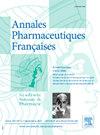Release of chlororotetracycline hydrochloride from novel hydrogels based on crosslinked chitosan and PVA
IF 1.1
Q4 PHARMACOLOGY & PHARMACY
引用次数: 0
Abstract
Hydrogels based on hydrochloride polyvinyl alcohol (PVA) containing chlortetracycline and crosslinked chitosan (CS) by glutaraldehyde (GLA) were prepared by the freeze-thawing method and then characterized. The swelling properties and gel fraction of these hydrogels were studied and characterized by FTIR spectroscopy, the thermal and mechanical properties were evaluated by DSC and rheology. Controlled release of chlortetracycline hydrochloride from these hydrogels was studied by UV–Visible spectroscopy. The gel fraction decreases with increase of crosslinked chitosan concentration in hydrogel but the swelling was more important due to the relaxation of the hydrogel, and the extension of macromolecular chains in the system. The crystallinity of these hydrogels increased with increasing PVA concentration. All these hydrogels exhibited a gel character with a high crosslinking degree and possessed a network structure. The release of chlortetracycline hydrochloride from these hydrogels was occurred by fickian diffusion, faster at 37 °C than at 25 °C because hydrogels were more swollen at 37 °C and their network densities were decreased to perfect the release of drugs from hydrogels.
Des hydrogels à base de polyalcool vinylique (PVA) et de chitosane (CS) réticulé par le glutaraldéhyde (GLA) contenant de la chlortétracycline ont été préparés par la méthode de congélation-décongélation puis caractérisés. Les propriétés de gonflement et la fraction de gel de ces hydrogels ont été étudiées et caractérisées par spectroscopie FTIR. Les propriétés thermiques et mécaniques ont été évaluées par DSC et rhéologie. La libération contrôlée de l’hydrochlorure de chlortétracycline à partir de ces hydrogels a été étudiée par spectroscopie UV–Visible. La fraction de gel diminue avec l’augmentation de la concentration en chitosane réticulé dans l’hydrogel, mais le gonflement est plus important en raison de la relaxation de l’hydrogel et de l’extension des chaînes macromoléculaires dans le système. La cristallinité de ces hydrogels a augmenté avec l’augmentation de la concentration de PVA. Tous ces hydrogels présentent un caractère de gel avec un degré de réticulation élevé et possèdent une structure de réseau. La libération de l’hydrochlorure de chlortétracycline à partir de ces hydrogels s’est produite par diffusion fickienne, plus rapide à 37 °C qu’à 25 °C car les hydrogels étaient plus gonflés à 37 °C et leurs densités de réseau étaient réduites, facilitant ainsi la libération des médicaments à partir des hydrogels.
新型壳聚糖-聚乙烯醇交联水凝胶释放氯四环素的研究。
采用冻融法制备了含氯四环素的盐酸聚乙烯醇(PVA)和戊二醛(GLA)交联壳聚糖(CS)水凝胶,并对其进行了表征。采用红外光谱(FTIR)对其溶胀性能和凝胶组分进行了表征,并用DSC和流变学对其热性能和力学性能进行了表征。用紫外可见光谱法研究了盐酸氯四环素凝胶的控释效果。随着交联壳聚糖浓度的增加,凝胶分数降低,但由于水凝胶的松弛和体系中大分子链的延伸,凝胶膨胀更为重要。这些水凝胶的结晶度随着PVA浓度的增加而增加。所有的水凝胶都表现出高交联度的凝胶特性,并具有网状结构。盐酸氯四环素的释放是通过黏性扩散进行的,在37℃时比在25℃时更快,因为在37℃时水凝胶更肿胀,其网络密度降低,以完善药物从水凝胶中的释放。
本文章由计算机程序翻译,如有差异,请以英文原文为准。
求助全文
约1分钟内获得全文
求助全文
来源期刊

Annales pharmaceutiques francaises
PHARMACOLOGY & PHARMACY-
CiteScore
1.70
自引率
7.70%
发文量
98
期刊介绍:
This journal proposes a scientific information validated and indexed to be informed about the last research works in all the domains interesting the pharmacy. The original works, general reviews, the focusing, the brief notes, subjected by the best academics and the professionals, propose a synthetic approach of the last progress accomplished in the concerned sectors. The thematic Sessions and the – life of the Academy – resume the communications which, presented in front of the national Academy of pharmacy, are in the heart of the current events.
 求助内容:
求助内容: 应助结果提醒方式:
应助结果提醒方式:


